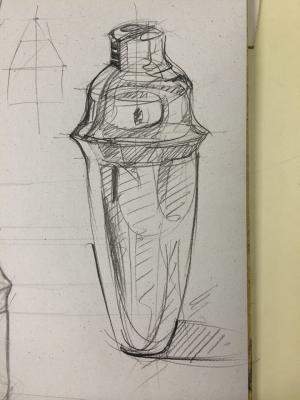
An introduction to the visual language and process of "drawing-by-hand for designers" through the direct-observation of the physical world, based on human visual perception and by applying basic rules of Euclidean Geometry that aid in the analysis and composition of flat shapes (2D planes) and surfaces of 3D objects and the understanding of 3D space. Emphasis is placed on the analytical approach to drawing from careful observation of the visible environment and elements within it using assessment of measurements and proportions and making comparisons between them (free drawing). Practice of analog drawing from observation as to gradually improve the ability to execute sketches from physical models of objects in space, applying methods of analysis of flat or curved forms, their outline, and the relationships of such forms to the background with the effect of shadow and light on tone rendering (positive negative space). Approaching hand- drawing by representing natural and man-made structures of small and large scale, of industrially and mass-produced objects. No prior knowledge of drawing is required, nor is the ability to "draw straight lines" required in this course. Emphasis is placed on continuous practice and careful drawing practice through Studio exercises and exercises performed at home. Free-hand drawing and sketching from observation are a key-skills for Illustrators and Designers and have proven useful tools in design practice at the initial stages of the "ideation" process, in next semesters’ Studios. An electronic portfolio of all drawing practice and assignmentsis created for the required final presentation and assessment. Weekly participation of this Studio is mandatory. (A. Brisnovali 2022-23)
- drawing mediums and materials surfaces for drawing • lines (contour) and tone gradation (rendering)
- proportions and measurements – transferring of proportions
- basic rules of Euclidean Geometry applied to the drawing of surfaces and volumes
- representation of structure for basic geometric solids • techniques for drawing of two-dimensional surfaces and rendering of three-dimensional volumes
- theory of 1, 2 & 3 (Vanishing) Point Perspective applied on small/large scale objects
- perspectival drawings for interior space compositions and exterior architectural space
- introduction to sketching for design – objects & composition • composition - complex structures (intersecting volumes) representation of multiple viewpoints
- organic forms – construction of contour-lines and rendering of volume by
- expressive lines
- tone, gradation, line, and shadow – simplification for use in design Sketching
- color – tonal rendering techniques and color combination rendering options
- introduction to drawing with computer programs (Photoshop) and Wacom pen environment
By completing the first semester of the first year, students will be able to comfortably use basic drawing techniques to render 3D volumes on 2D surfaces, as well as represent with ease the structures of basic geometric solids, objects, perspectival spaces, and compositions of organic forms. Students will be familiar with the use of expressive line, tone, and color as they perceive them. In addition, by using SKETCHING techniques, they will be able to analyze and compose, with relative speed and accuracy, both physical images and idealized 3D spaces & objects. Emphasis is placed on continuous practice and the use of different drawing tools and materials such as pencils, charcoal, ink, colored pencils, markers and drawing surfaces such as different papers and digital drawing boards (with stylus).
1. Klara Sjölén & Allan Macdonald. (2011). Learning Curves. KEEOS Design Books.
2. Klara Sjölen & Erik Olofsson (2005). Design Sketching. KEEOS Design Books.


